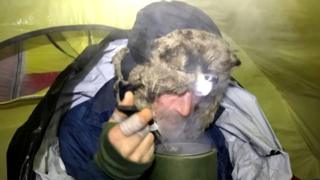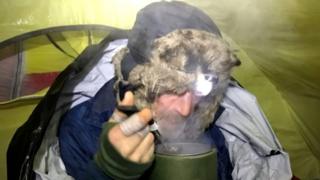Hungry North Pole explorers Horn and Ousland near end of epic trek
The Norwegian-South African duo are tired and hungry after trekking hundreds of miles. …

 Image copyright Mike Horn website
Image copyright Mike Horn website Two explorers are short of food and battling strong winds after trekking hundreds of miles at the North Pole, but they hope to reach safety soon.
South African Mike Horn and Norwegian Boerge Ousland have covered about 1,800km (1,120 miles) on treacherous drifting ice. Because of delays their food is likely to run out on Friday.
However, two other Norwegians have gone to meet them and the teams are reckoned to be about 8km (five miles) apart.
A polar research ship is also nearby.
The latest Instagram update on the Horn-Ousland team’s progress says they have advanced beyond the meeting point they had set with the other explorers.
However, Horn said earlier that they were battling frostbite at -40C temperatures.
Expedition organiser Lars Ebbesen is maintaining contact with both teams via satellite phone.
Speaking to the BBC from Oslo, Ebbesen said team Horn-Ousland did not want to be rescued by helicopter – instead they agreed to the meet-up arrangement with the Norwegian pair.
He added that “the wind is building up in the area and they have little food left – if they get trapped in a storm there isn’t enough food”.
A key aim of the expedition is to collect data on the Arctic ice melt, which scientists attribute to global warming. The journey began on the Alaskan side of the North Pole and it should end in Svalbard, a Norwegian Arctic archipelago.
The polar research ship Lance, also Norwegian, has sailed through sea ice, with difficulty, to get near to the explorers. They are now about two days’ trek from it.
Read more on related topics:
The Norwegian pair – Bengt Rotmo and Aleksander Gamme – camped on the ice overnight and are carrying food for team Horn-Ousland.
“The problem is the ice is fast-moving now, at two to three hundred metres (yards) an hour. So it’s finely balanced,” Ebbesen said.
Sometimes at night, when team Horn-Ousland were camping, the drifting ice moved them backwards, adding to the distance they had to cover. They had planned to finish their trek in mid-November.
Thinner polar ice than normal added to the risks they faced, Ebbesen said.
“They had to do this when the ice [extent] was smallest, and all in pitch dark,” he said. “The whole polar ice sheet is smaller this year than at any time – only 2016 was like this.”


